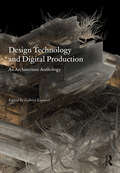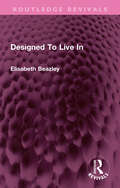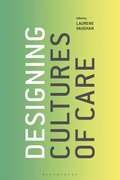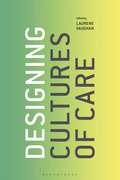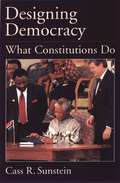- Table View
- List View
Design Technology and Digital Production: An Architecture Anthology
by Gabriel EsquivelThis book is a rigorous account of architecture’s theoretical and technological concerns over the last decade. The anthology presents projects and essays produced at the end of the first digital turn and the start of the second digital turn. This anthology engages and deploys a variety of discourses, topics, criteria, pedagogies, and technologies, including some of today’s most influential architects, practitioners, academics, and critics. It is an unflinchingly rigorous and unapologetic account of architecture’s disciplinary concerns in the last decade. This is a story that has not been told; in recent years everything has been refracted through the prism of the post-digital generation.Design Technology and Digital Production illustrates the shift to an architectural world where we can learn with and from each other, develop a community of new technologies and embrace a design ecology that is inclusive, open, and visionary. This collection fosters a sense of shared experience and common purpose, along with a collective responsibility for the well-being of the discipline of architecture as a whole.
Design Technology and Digital Production: An Architecture Anthology
This book is a rigorous account of architecture’s theoretical and technological concerns over the last decade. The anthology presents projects and essays produced at the end of the first digital turn and the start of the second digital turn. This anthology engages and deploys a variety of discourses, topics, criteria, pedagogies, and technologies, including some of today’s most influential architects, practitioners, academics, and critics. It is an unflinchingly rigorous and unapologetic account of architecture’s disciplinary concerns in the last decade. This is a story that has not been told; in recent years everything has been refracted through the prism of the post-digital generation.Design Technology and Digital Production illustrates the shift to an architectural world where we can learn with and from each other, develop a community of new technologies and embrace a design ecology that is inclusive, open, and visionary. This collection fosters a sense of shared experience and common purpose, along with a collective responsibility for the well-being of the discipline of architecture as a whole.
Design Theory, Language and Architectural Space in Lewis Carroll (Routledge Research in Design History)
by Caroline DionneThis volume offers spatial theories of the emergent based on a careful close reading of the complete works of nineteenth-century writer and mathematician Lewis Carroll—from his nonsense fiction, to his work on logic and geometry, including his two short pamphlets on architecture. Drawing on selected key moments in our philosophical tradition, including phenomenology and sociospatial theories, Caroline Dionne interrogates the relationship between words and spaces, highlighting the crucial role of language in processes of placemaking. Through an interdisciplinary method that relates literary and language theories to theories of space and placemaking, with emphasis on the social and political experience of architectural spaces, Dionne investigates Carroll’s most famous children’s books, Alice’s Adventures in Wonderland and Through the Looking-Glass and What Alice Found There, in relation to his lesser-known publications on geometry and architecture. The book will be of interest to scholars working in design theory, design history, architecture, and literary theory and criticism.
Design Theory, Language and Architectural Space in Lewis Carroll (Routledge Research in Design History)
by Caroline DionneThis volume offers spatial theories of the emergent based on a careful close reading of the complete works of nineteenth-century writer and mathematician Lewis Carroll—from his nonsense fiction, to his work on logic and geometry, including his two short pamphlets on architecture. Drawing on selected key moments in our philosophical tradition, including phenomenology and sociospatial theories, Caroline Dionne interrogates the relationship between words and spaces, highlighting the crucial role of language in processes of placemaking. Through an interdisciplinary method that relates literary and language theories to theories of space and placemaking, with emphasis on the social and political experience of architectural spaces, Dionne investigates Carroll’s most famous children’s books, Alice’s Adventures in Wonderland and Through the Looking-Glass and What Alice Found There, in relation to his lesser-known publications on geometry and architecture. The book will be of interest to scholars working in design theory, design history, architecture, and literary theory and criticism.
Design Thinking: Understanding How Designers Think and Work
by Nigel CrossDesign thinking is the core creative process for any designer; this book explores and explains this apparently mysterious design ability. This new edition is a completely revised, updated and extended version of a classic text.Focusing on what designers actually do when they are designing, the book is structured around a series of in-depth case studies of the work of outstanding and expert designers, interwoven and developed with commentary and comparison. The coverage reflects the breadth of design from architecture to engineering, consumer products to communications, and from individual designing to teamwork and collaborative designing. The scale of designing ranges from Formula One racing cars to city commuting cars, locomotives to bicycles, sewing machines to litter bins and lemon squeezers. The book is based on evidence from observation and investigation of design practice, providing insights into and understanding of design thinking, and the development of design ability from novice to expert.This second edition of Design Thinking: Understanding How Designers Think and Work offers an overview from one of design's most experienced and influential scholars. Nigel Cross goes to the heart of what it means to think and work as a designer. It is an ideal guide for anyone who wants to become a designer or to know how good designers work in the field of contemporary design.
Design Thinking: Understanding How Designers Think and Work
by Nigel CrossDesign thinking is the core creative process for any designer; this book explores and explains this apparently mysterious design ability. This new edition is a completely revised, updated and extended version of a classic text.Focusing on what designers actually do when they are designing, the book is structured around a series of in-depth case studies of the work of outstanding and expert designers, interwoven and developed with commentary and comparison. The coverage reflects the breadth of design from architecture to engineering, consumer products to communications, and from individual designing to teamwork and collaborative designing. The scale of designing ranges from Formula One racing cars to city commuting cars, locomotives to bicycles, sewing machines to litter bins and lemon squeezers. The book is based on evidence from observation and investigation of design practice, providing insights into and understanding of design thinking, and the development of design ability from novice to expert.This second edition of Design Thinking: Understanding How Designers Think and Work offers an overview from one of design's most experienced and influential scholars. Nigel Cross goes to the heart of what it means to think and work as a designer. It is an ideal guide for anyone who wants to become a designer or to know how good designers work in the field of contemporary design.
Design Thinking in Cultural and Heritage Management: Creating Solutions in the Field of Culture (ISSN)
by Lubomira Trojan Łukasz WróblewskiThe ability to discover and respond to societal needs in the field of culture requires an integrated, interdisciplinary, and cross-sectoral approach. Such a holistic view is offered by the design thinking method, which has been extracted from the field of design and could be applied also in the sphere of culture. Interdisciplinarity and consideration of users' needs are characteristics of contemporary design and can be a significant support when faced with the challenges of cultural heritage management. The abovementioned factors act as the premise behind undertaking an analysis of the possibility of adapting the design thinking method to the management of intangible cultural heritage, and to develop a model of the design thinking process for this area. This research volume is the first comprehensive study of the application of the design thinking method to cultural management, especially management of the intangible cultural heritage. It asserts that design thinking can bring numerous benefits to organizations involved in the management of intangible cultural heritage and to its depositories. It will be of interest to researchers and academics in the fields of public and nonprofit management, strategic management, and value creation in the field of culture; students of design for culture and heritage; and practitioners in cultural management.
Design Thinking in Cultural and Heritage Management: Creating Solutions in the Field of Culture (ISSN)
by Lubomira Trojan Łukasz WróblewskiThe ability to discover and respond to societal needs in the field of culture requires an integrated, interdisciplinary, and cross-sectoral approach. Such a holistic view is offered by the design thinking method, which has been extracted from the field of design and could be applied also in the sphere of culture. Interdisciplinarity and consideration of users' needs are characteristics of contemporary design and can be a significant support when faced with the challenges of cultural heritage management. The abovementioned factors act as the premise behind undertaking an analysis of the possibility of adapting the design thinking method to the management of intangible cultural heritage, and to develop a model of the design thinking process for this area. This research volume is the first comprehensive study of the application of the design thinking method to cultural management, especially management of the intangible cultural heritage. It asserts that design thinking can bring numerous benefits to organizations involved in the management of intangible cultural heritage and to its depositories. It will be of interest to researchers and academics in the fields of public and nonprofit management, strategic management, and value creation in the field of culture; students of design for culture and heritage; and practitioners in cultural management.
Design Thinking In Der Industrie: Strategien Für Den Organisationalen Wandel? (Design Ser. #51)
by Andrea AugstenDesign Thinking ist zu einem Modethema geworden, mit dem Unternehmen gerne ihre Zukunftsorientierung betonen. In der Praxis bleiben Vorstellungen von Inhalt und strategischer Zielsetzung jedoch oft vage, während etablierte Kulturen und Strukturen der Umsetzung zusätzlich im Weg stehen. Andrea Augsten untersucht als teilnehmende Beobachterin die Einführung von Design Thinking im Volkswagen Konzern. Ihre yse stellt vier Spannungsfelder heraus, die den Erfolg eines menschzentrierten, systemischen Organisationswandels bestimmen. Sie gibt Handlungsempfehlungen für das Management und bereichert die Designtheorie um ein empiriebasiertes Konzept von Design als Praxis der Organisationsgestaltung.
Design to Grow: How Coca-Cola Learned to Combine Scale and Agility (and How You Can, Too)
by David Butler Linda TischlerTomorrow's business winners need two things: scale and agility. The answer to both is design. For over a century, The Coca-Cola Company has used design to scale its flagship brand to over 200 countries. And in recent years it has sustained that growth while becoming even more agile - something most established businesses struggle with. In Design to Grow, Coca-Cola's vice president of Innovation and Entrepreneurship David Butler gives an unprecedented behind-the-scenes look at Coca-Cola's design-led strategy for growth. He shows how any business can use the same approach to get to the next level.Clear and actionable, this book is a must-read for leaders, creatives and entrepreneurs.'A handy blueprint for how any company can use design to stay ahead of the competition' The Times'Reading Design to Grow has caused me to think differently about my company. I am confident it will do the same for how you think about yours' Tim Brown, CEO of IDEO
Design und Improvisation: Produkte, Prozesse und Methoden (Design #34)
by Annika FryeDesigner_innen müssen improvisieren, wenn sie entwerfen. Die Entwicklung des Braun-Rasierapparates ebenso wie die Arbeiten des Designers Sebastian Herkner zeigen, dass Improvisation Modelle und Prototypen hervorbringt und Fertigungsprozesse überlistet. Doch Improvisation ist nicht nur eine Notwendigkeit - sie ist auch konzeptionell von Bedeutung. Als formgebendes Prinzip führt sie seit dem gestalterischen Postmodernismus zu eigenständigen Einzelstücken. In der Nachkriegszeit versuchte man jedoch, Design als einen Planungsprozess darzustellen. Annika Frye belegt: Für diesen rationalistischen Designbegriff, der bis heute die Diskurse über Design prägt, erweist sich ein am Prozess und seinen Improvisationen orientiertes Designkonzept als äußerst folgenreich.
Design und Transformation: Wie wir unsere Zukunft nachhaltig gestalten (Design #59)
by Markus CaspersTransformation ist ein Schlüsselbegriff unserer Zeit: Die Umwandlung und Umgestaltung vieler Bereiche des Lebens, vor allem des Umgangs mit Ressourcen, sind drängender denn je. Markus Caspers zeigt auf, wie »Transformation Design« sinnhafte Lösungen für diesen Prozess bereitstellen kann. Hierfür zeichnet er die Traditionslinien transformativer Ansätze im Design seit 1920 nach und befragt sie auf potenzielle Anknüpfungspunkte für die Zukunft. Unter Betrachtung von Formen und Bildern entwirft er nebst Schilderung der drängenden existenziellen Probleme auch positive Zukunftsszenarien neuer Lebens- und Konsumstile jenseits von Lifecycle- und Konsumismus-Ideologien.
Designästhetik: Theorie und soziale Praxis (Medien- und Gestaltungsästhetik #8)
by Oliver Ruf Stefan NeuhausDesign ist allgegenwärtig - es durchtränkt gleichsam das Leben, oftmals unbewusst, doch immer durchscheinend und folgenhaft. Es ist Bestandteil des Habitus und unverzichtbarer Teil einer jeden Identität. Selbst im bewussten Verzicht auf Design kommt eine spezifische Designästhetik zum Ausdruck, die anders sein möchte. Doch welche Normierungen greifen hier und dienen als Orientierung für Absetzbewegungen? Dies zeigt sich vor allem in der Prägung durch massenmediale Diskurse. Die Beiträge des Bandes entwickeln zu diesem zentralen Dispositiv einen theoretischen wie praktischen Rahmen und reflektieren Indikatoren für entsprechende Leistungen.
Designated Targets: World War 2.2 (Axis Of Time Ser. #2)
by John BirminghamThe Second World War was turned on its head at the moment Admiral Kolhammer’s ultra-modern stealth warships were hurled back through time from 2021. But no one could have predicted just how much of a nightmare would ensue . . . Only months after the Transition, the great powers scramble to develop the weapons of tomorrow. The year 1942 is now a world of crude jet fighters, monstrous attack helicopters, and unholy dirty bombs — a mongrel technology, born decades prematurely. Then, in a radical rewriting of history, Japanese forces sweep into Australia, foreign agents begin a campaign of terror in the USA, and Germany prepares for an all-out attack on Britain. The twenty-first-century forces must resort to the most extreme measures yet and face a future rife with possibilities — all of them apocalyptic . . . Picking up from where he left off with Weapons of Choice, John Birmingham shocks and awes us with this gripping second instalment in the Axis of Time trilogy.
Designed To Live In (Routledge Revivals)
by Elisabeth BeazleyOriginally published in 1962, this book traces the main influences behind modern design in domestic architecture. It does so against the context of the effect each new dwelling has on its environment and the effect its design has on those in the surrounding (and often older, historic) housing stock. Diverse influences such as the bye-law street and Le Corbusier’s Ville Radieuse are discussed, while the ideas bearing on the individual private house range from those of the early nineteenth century villa builders to Frank Lloyd Wright’s prairie houses and the work of Mies van der Rohe. The book closes with a detailed discussion of the problems and possibilities of domestic design in house-building in the late 20th Century
Designed To Live In (Routledge Revivals)
by Elisabeth BeazleyOriginally published in 1962, this book traces the main influences behind modern design in domestic architecture. It does so against the context of the effect each new dwelling has on its environment and the effect its design has on those in the surrounding (and often older, historic) housing stock. Diverse influences such as the bye-law street and Le Corbusier’s Ville Radieuse are discussed, while the ideas bearing on the individual private house range from those of the early nineteenth century villa builders to Frank Lloyd Wright’s prairie houses and the work of Mies van der Rohe. The book closes with a detailed discussion of the problems and possibilities of domestic design in house-building in the late 20th Century
Designer Politics: How Elections Are Won
by Margaret ScammellThis is the first book to offer a serious examination of the phenomenon of political marketing in Britain. It presents an analysis of the increasingly influential role of the image-makers and casts a critical eye over the debate concerning the impact of marketing on political conduct and governance. Its primary focus is party and government communications in the Thatcher era and beyond, up to and including the 1992 general election. It argues that Thatcher, despite her image as the resolute politician, pioneered marketing techniques and concepts which have since become standard practice. Designer Politics looks at the historical engines of growth of commercial salesmanship in politics. It explores how political culture and conduct have been affected by the phenomenon and to what extent politics and policy have been remoulded to fit the marketing process. The author challenges the prevailing pessimism that Britain is hurtling towards American presidential-style campaigns and that marketing necessarily demeans and undermines democracy. While there are inherent dangers, there also comes new potential for a more genuinely popular democracy.
Designers, Users and Justice
by Turkka KeinonenHow do we design for users? How might users best participate in the design process? How can we evaluate the user's experience of designed products and services? These fundamental questions are addressed in Designers, Users, and Justice, through a series of dialogues between a design scholar and a designer. In a series of conversations, the scholar and the designer address the concepts and practice of user centred design, examining whether a 'just method' necessarily leads to a just design, consider different models for understanding user experience and socially productive design, including the capability approach and utilitarianism, and ponder how an ethical framework for evaluating design might be developed. Throughout, the scholar and the designer draw on their particular experiences in design practice and design education, and propose alternative conceptualisations of the key ideas of user centred design, highlighting and seeking to address the ethical shortcomings of mainstream user centred design practice.
Designers, Users and Justice
by Turkka KeinonenHow do we design for users? How might users best participate in the design process? How can we evaluate the user's experience of designed products and services? These fundamental questions are addressed in Designers, Users, and Justice, through a series of dialogues between a design scholar and a designer. In a series of conversations, the scholar and the designer address the concepts and practice of user centred design, examining whether a 'just method' necessarily leads to a just design, consider different models for understanding user experience and socially productive design, including the capability approach and utilitarianism, and ponder how an ethical framework for evaluating design might be developed. Throughout, the scholar and the designer draw on their particular experiences in design practice and design education, and propose alternative conceptualisations of the key ideas of user centred design, highlighting and seeking to address the ethical shortcomings of mainstream user centred design practice.
Designing Business and Management
by Sabine Junginger Jürgen FaustScholars and practitioners from management and design address the challenges and issues of designing business from a design perspective. Designing Business and Management combines practical models and grounded theories to improve organizations by design. For designing managers and managing designers, the book offers visual and conceptual models as well as theoretical concepts that connect the practice of designing with the activities of changing, organizing and managing. The book zooms in on designing beyond products and services. It focuses on designing businesses with a particular onus on social business and social entrepreneurship. Designing Business and Management contributes to and enhances the discourse between leading design and management scholars; offers a first outline of issues, concepts, practices, methods and principles that currently represent the body of knowledge pertaining to designing business, with a special focus on perceiving business as a social activity; and explores the practices of designing and managing, their commonalities, distinctions and boundaries.
Designing Business and Management
by Sabine Junginger Jürgen FaustScholars and practitioners from management and design address the challenges and issues of designing business from a design perspective. Designing Business and Management combines practical models and grounded theories to improve organizations by design. For designing managers and managing designers, the book offers visual and conceptual models as well as theoretical concepts that connect the practice of designing with the activities of changing, organizing and managing. The book zooms in on designing beyond products and services. It focuses on designing businesses with a particular onus on social business and social entrepreneurship. Designing Business and Management contributes to and enhances the discourse between leading design and management scholars; offers a first outline of issues, concepts, practices, methods and principles that currently represent the body of knowledge pertaining to designing business, with a special focus on perceiving business as a social activity; and explores the practices of designing and managing, their commonalities, distinctions and boundaries.
Designing Concerns: Bruno Latour und das Transformation Design (Design #61)
by Peter Friedrich StephanWie lassen sich die Akteur-Netzwerk-Theorie und das Werk Bruno Latours auf die Gestaltung gesellschaftlicher Transformation beziehen? Peter Friedrich Stephan nimmt Latours Forderung nach einer »Revision der Moderne« als Ausgangspunkt für die Entwicklung des Concern Designs. An der Schnittstelle der Designtheorie mit den Sozial- bzw. Kulturwissenschaften werden die praktischen Folgen einer »Wunsch-Ökonomie« entwickelt, auch unter Bezug auf Deleuze/Guattari. Concerns werden dabei im Sinne der Praxeologie als »Werte in Aktion« verstanden. Diagramme wie die »Concern Canvas« und der »Hyperzyklus der Transformation« bieten Ansatzpunkte für die praktische Arbeit im Transformation Design.
Designing Cultures of Care
by Laurene VaughanDesigning Cultures of Care brings together an international selection of design researchers who, through a variety of design approaches, are exploring the ways in which design intersects with cultures of care. Unique in its focus and disciplinary diversity, this edited collection develops an expanded discourse on the role and contribution of design to our broader social, cultural and material challenges. Based around a unifying critique of the proposition of care as a theoretical framework for undertaking design research in real worldcontexts, each chapter presents a case study of design research in action.This book aims to provide readers - both academics and practitioners - with insights into the possibilities and challenges of designing cultures of care. The disciplines represented in this collection include architecture, visual communication, participatory and social design, service design, critical and speculative design interventions and design ethnography. These case studies will provide real world insights that have relevance and value to design students at both undergraduate and postgraduate levels, and to researchers at all levels within and outside of the academy.
Designing Cultures of Care
by Laurene VaughanDesigning Cultures of Care brings together an international selection of design researchers who, through a variety of design approaches, are exploring the ways in which design intersects with cultures of care. Unique in its focus and disciplinary diversity, this edited collection develops an expanded discourse on the role and contribution of design to our broader social, cultural and material challenges. Based around a unifying critique of the proposition of care as a theoretical framework for undertaking design research in real worldcontexts, each chapter presents a case study of design research in action.This book aims to provide readers - both academics and practitioners - with insights into the possibilities and challenges of designing cultures of care. The disciplines represented in this collection include architecture, visual communication, participatory and social design, service design, critical and speculative design interventions and design ethnography. These case studies will provide real world insights that have relevance and value to design students at both undergraduate and postgraduate levels, and to researchers at all levels within and outside of the academy.
Designing Democracy: What Constitutions Do
by Cass R. Sunstein"In modern nations, political disagreement is the source of both the gravest danger and the greatest security," writes Cass Sunstein. All democracies face intense political conflict. But is this conflict necessarily something to fear? In this provocative book, one of our leading political and legal theorists reveals how a nation's divisions of conviction and belief can be used to safeguard democracy. Confronting one explosive political issue after another, from presidential impeachment to the limits of religious liberty, from discrimination against women and gays to the role of the judiciary, Sunstein constructs a powerful new perspective from which to show how democracies negotiate their most divisive real-world problems. He focuses on a series of concrete concerns that go to the heart of the relationship between the idea of democracy and the idea of constitutionalism. Illustrating his discussion with examples from constitutional debates and court-cases in South Africa, Eastern Europe, Israel, America, and elsewhere, Sunstein takes readers through a number of highly charged questions: When should government be permitted to control discriminatory behavior by or within religious organizations? Does it make sense to govern on the basis of popular referenda? Can the right to have an abortion be defended? Can we defend Internet regulation? Should the law step in if children are being schooled in discriminatory preferences and beliefs? Should a constitution protect rights to food, shelter, and health care? Disputes over questions such as these can be fierce enough to pose a grave threat. But in a paradox whose elaboration forms the core of Sunstein's book, it is a nation's apparently threatening diversity of opinion that can ensure its integrity. Extending his important recent work on the way deliberation within like-minded groups can produce extremism, Sunstein breaks new ground in identifying the mechanisms behind political conflict in democratic nations. At the same time, he develops a profound understanding of a constitutional democracy's system of checks and balances. Sunstein shows how a good constitution, fostering a "republic of reasons," enables people of opposing ethical and religious commitments to reach agreement where agreement is necessary, while making it unnecessary to reach agreement when agreement is impossible. A marvel of lucid, subtle reasoning, DESIGNING DEMOCRACY makes invaluable reading for anyone concerned with the promises and pitfalls of the democratic experiment.
